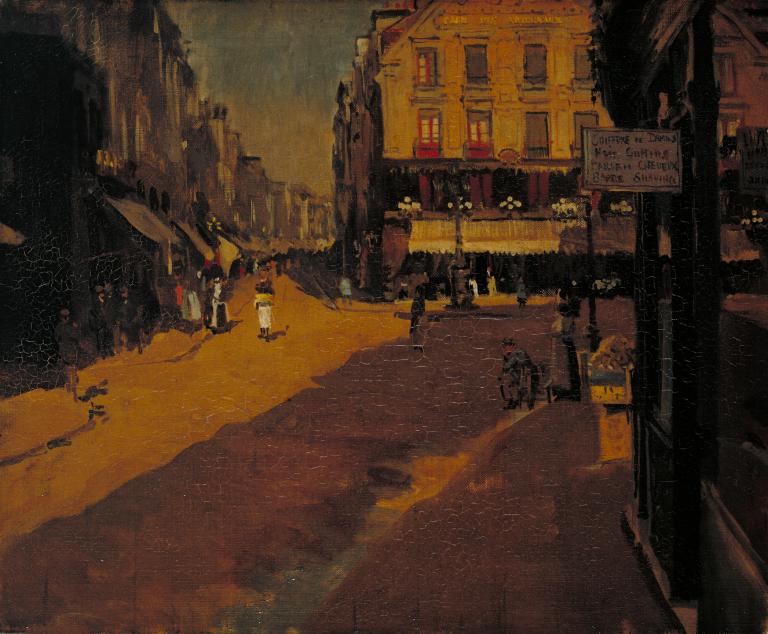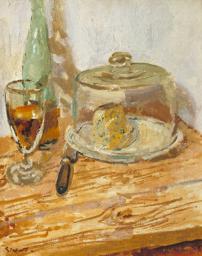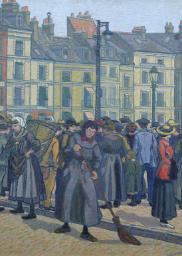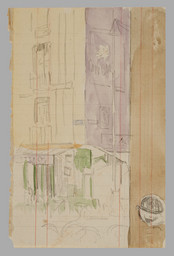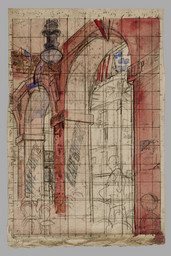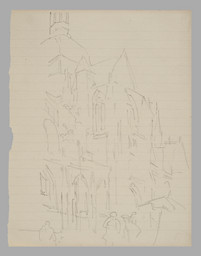Walter Richard Sickert Café des Tribunaux, Dieppe c.1890
Walter Richard Sickert,
Café des Tribunaux, Dieppe
c.1890
Walter Sickert first visited Dieppe in 1879 with his parents and regularly returned, often for extended periods, to live and work there. This daytime view shows the fashionable Café des Tribunaux in the middle distance, with the shops lining the Grande Rue receding into the sunlight beyond. A technically complex reflection of the café is painted in the window of the barber-shop on the right.
Walter Richard Sickert 1860–1942
Café des Tribunaux, Dieppe
c.1890
Oil paint on canvas
605 x 732 mm
Presented by Sylvia Gosse 1917
N03182
c.1890
Oil paint on canvas
605 x 732 mm
Presented by Sylvia Gosse 1917
N03182
Ownership history
Purchased by Sylvia Gosse from the Carfax Gallery, London, c.1912 and presented to Tate Gallery 1917.
Exhibition history
1891
New English Art Club, Spring 1891 (42, as ‘Dieppe’).
1904
?Walter Sickert, Bernheim-Jeune, Paris, June 1904 (45).
1911–12
?Loan Exhibition of Works Organised by the Contemporary Art Society, Manchester City Art Gallery, December 1911–January 1912 (65).
1912
?Loan Collection of Modern Paintings Organised by the Contemporary Art Society, Laing Art Gallery and Museum, Newcastle upon Tyne, October 1912 (192).
1936
Twee Eeuwen Engelsche Kunst, Stedelijk Museum, Amsterdam, July–October 1936 (136, reproduced).
1946
The One Hundred and Twentieth Exhibition of the Royal Scottish Academy of Painting, Sculpture, and Architecture, Royal Scottish Academy, Edinburgh, 1946 (83, as ‘Cafe des Tribiunaux, Dieppe’).
1957
Sickert: An Exhibition of Paintings, Drawings and Prints, Graves Art Gallery, Sheffield, August–September 1957 (14).
1960
Sickert: Paintings and Drawings, (Arts Council tour), Tate Gallery, London, May–June 1960, Southampton Art Gallery, July 1960, Bradford City Art Gallery, July–August 1960 (24).
1977–8
Sickert, (Arts Council tour), Ferens Art Gallery, Hull, December 1977–January 1978, Glasgow Art Gallery, February–March 1978, City Museum and Art Gallery, Plymouth, April–May 1978 (5, reproduced).
1989–90
W.R. Sickert: Drawings and Paintings 1890–1942, Tate Gallery, Liverpool, March 1989–February 1990, Tate Gallery, London, July–September 1990 (16, reproduced).
1992
The Dieppe Connection: The Town and its Artists from Turner to Braque, Brighton Museum and Art Gallery, May–June 1992 (66, reproduced).
1998
James McNeill Whistler, Walter Richard Sickert, Fundación “a Caixa”, Madrid, March–May 1998, Museo de Bellas Artes de Bilbao, May–July 1998 (70, reproduced).
2010
The Art of Walter Sickert, The Lightbox, Woking, May–July 2010 (no catalogue).
References
1891
Lloyds Weekly, 12 April 1891.
1891
Sunday Times, 12 April 1891.
1891
Daily Graphic, 13 April 1891.
1891
Echo, 16 April 1891.
1891
‘Pictures of the Year 1891’, Pall Mall Gazette Extra, London 1891, reproduced.
1921
Theodore Galerien, ‘The Renaissance of the Tate Gallery’, Studio, vol.82, no.344, November 1921, p.194.
1927
J.B. Manson, ‘Walter Richard Sickert, A.R.A.’, Drawing and Design, vol.3, July 1927, p.4.
1939
John Rothenstein, ‘Walter Richard Sickert’, Picture Post, 18 February 1939, reproduced.
1943
Lillian Browse and Reginald Howard Wilenski, Sickert, London 1943, pp.39–40, reproduced pl.12.
1954
Hubert Wellington, ‘With Sickert at Dieppe’, Listener, vol.52, no.1347, 23 December 1954, reproduced p.1111.
1955
Anthony Bertram, Sickert, London and New York 1955, reproduced pl.8.
1960
Lillian Browse, Sickert, London 1960, pp.23, 63, 87,100, reproduced pl.8.
1964
Mary Chamot, Dennis Farr and Martin Butlin, Tate Gallery Catalogues: The Modern British Paintings, Drawings and Sculpture, vol.2, London 1964, pp.621–2, reproduced pl.35.
1973
Wendy Baron, Sickert, London and New York 1973, pp.39, 308, no.65, reproduced pl.43.
1988
Richard Shone, Walter Sickert, Oxford 1988, reproduced pl.14.
1988
Laura Wortley, British Impressionism: A Garden of Bright Images, London 1988, reproduced p.126.
1992
Wendy Baron and Richard Shone (eds.), Sickert: Paintings, exhibition catalogue, Royal Academy, London 1992, p.38, reproduced fig.38.
2006
Wendy Baron, Sickert: Paintings and Drawings, New Haven and London 2006, no.84.
Technique and condition
Café des Tribunaux, Dieppe is painted on prepared stretched canvas. The stretcher is stamped ‘Modele De Pose/ B’ and although it is not known who supplied this type of pre-stretched canvas, the stamp suggests that it was a patented commercial support, probably supplied by a Dieppe colourman. Canvases could be bought pre-primed and stretched in a range of standard sizes, which were fixed for all French suppliers; each size was available in three formats: figure, paysage and marines; and a range of different weights: ordinaire, fine and coutil, for example.
For this painting Sickert chose an F20 canvas (figure, 0.70 x 0.60 m), loosely woven and of medium weight (ordinaire), but turned and used it in landscape format. He purchased the support pre-primed with a white ground, but again adapted it by applying a thin grey/brown layer onto the primer to act as an optical ground. He applied rich paint in a relatively fluid application to produce the buildings and the figures, which is clearly evident in the figures’ stylisation. In comparison to Sickert’s other works there is little real impasto, and the paint is brushed more smoothly from a less well-loaded brush.
The later visible paint appears to have been applied wet-in-wet, producing a spontaneous feel to the work. But from the grey/brown underlayer and the white priming through to the canvas tops there is evidence of underlying layers having been rubbed down. Sickert may have derived this practice from James Abbott McNeill Whistler who rubbed down his paintings after each sitting, starting again on the next sitting until the final coat was applied alla prima.1
The colours are generally opaque and would have appeared slightly higher in tone but have dulled as overlying paint layers have become more transparent and the effect of the grey/brown underlayer has become more pronounced in the areas of thinner and darker paint. The painting has been varnished with a soft resin, which was probably applied by the artist.
Stephen Hackney and Roy Perry
July 2004
Notes
Alla prima originates from the Italian, meaning ‘at once’. It is generally accepted to refer to a method of painting in one sitting, usually painting wet-in-wet, in contrast to building up a painting in several planned stages or layers. It is sometimes also called direct painting. Whistler used the term to describe his painting technique, but it may have a particular meaning when applied to his works and, indeed, Sickert’s. See Stephen Hackney, ‘Colour and Tone in Whistler’s “Nocturnes” and “Harmonies” 1871–2’, Burlington Magazine, vol.136, no.1099, October 1994, pp.695–9.
How to cite
Stephen Hackney and Roy Perry, 'Technique and Condition', July 2004, in Robert Upstone, ‘Café des Tribunaux, Dieppe c.1890 by Walter Richard Sickert’, catalogue entry, May 2009, in Helena Bonett, Ysanne Holt, Jennifer Mundy (eds.), The Camden Town Group in Context, Tate Research Publication, May 2012, https://wwwEntry
First exhibited under the title Dieppe at the April exhibition of the New English Art Club in 1891, Walter Sickert’s picture attracted only modest critical attention, although all of it was positive. Generally the show received few reviews, and most of those focused on Philip Wilson Steer’s Mrs Cyprian Williams (Tate N04422). The Sunday Times noted of the exhibition that:
The present collection offers nothing to shock or amaze the average picture buyer. Mr Walter Sickert gives us no more startling studies of the music-halls ... [he] has never done anything better than ‘Dieppe’, a vivid vision of the place that palpitates with actuality, and is entirely pictorial.1
The Echo concurred, writing that Sickert was
usually the amusingly eccentric exhibitor at these shows. But this year it has pleased him to demonstrate to the outer public that there was something in his private reputation. His ‘Dieppe’, a street scene, a blue picture in a black frame, is full of motion, light, and sparkle, happy and true, distinctly the best thing he has ever shown.2
The Café des Tribunaux was one of the best-known landmarks of Dieppe, and continues its trade today. It stands at the focal point of the town on the Puits Salé, where two streets that run up from the harbour side, the Rue St Jacques and the Grande Rue, converge. Sickert shows the view down the Grande Rue, the main shopping street of Dieppe. Since 1945 the café has been refaced and the Grande Rue widened, so that the shops on the right of the picture no longer exist.
Dieppe was a popular town with British visitors and holidaymakers in this period, and the Café des Tribunaux was a common destination. As a familiar sight it might be assumed that the subject would appeal to picture buyers. The prominent British presence in Dieppe is attested to by the barber’s sign on the right of Sickert’s picture which is partly in English. Sickert himself had a long-standing connection with the town. He first went there on holiday with his parents in August 1879 and after his engagement in 1885 visited regularly. Later he had a studio there and spent much of his time between 1895 and 1905 in the town. Dieppe became a focus for a long series of paintings by Sickert from this time (including Tate N05045, N05094, N05096), but it also formed the subject of some of his earliest works, small oil on panel studies from 1885 of the beach and local sites.3
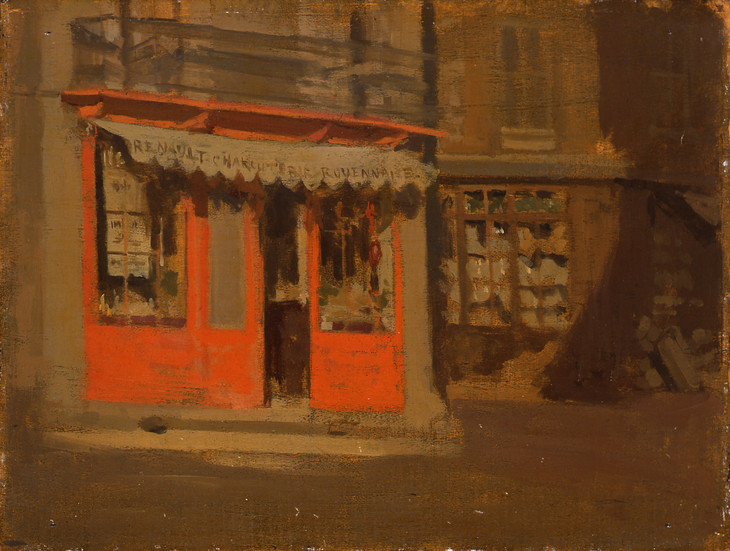
Walter Richard Sickert 1860–1942
The Red Shop (The October Sun) c.1888
Oil on panel
267 x 356 mm
Norwich Castle Museum and Art Gallery
© Estate of Walter R. Sickert / DACS 2010
Photo © Norwich Castle Museum and Art Gallery
Fig.1
Walter Richard Sickert
The Red Shop (The October Sun) c.1888
Norwich Castle Museum and Art Gallery
© Estate of Walter R. Sickert / DACS 2010
Photo © Norwich Castle Museum and Art Gallery
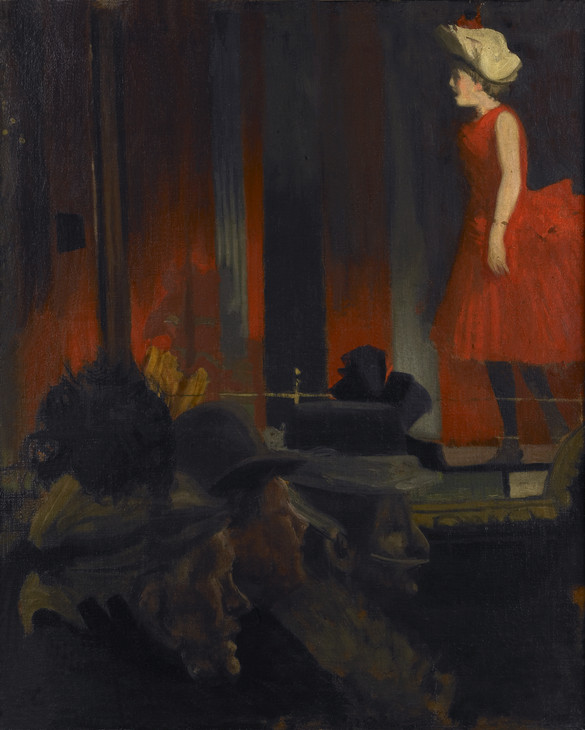
Walter Richard Sickert 1860–1942
The Music Hall or The P.S. Wings in the O.P. Mirror 1888–9
Oil paint on canvas
610 x 510 mm
Rouen, Musée des Beaux-Arts. Donation Jacques-Emile Blanche, 1922
© Estate of Walter R. Sickert / DACS
Photo © Musées de la Ville de Rouen. Photographie C. Lancien, C. Loisel
Fig.2
Walter Richard Sickert
The Music Hall or The P.S. Wings in the O.P. Mirror 1888–9
Rouen, Musée des Beaux-Arts. Donation Jacques-Emile Blanche, 1922
© Estate of Walter R. Sickert / DACS
Photo © Musées de la Ville de Rouen. Photographie C. Lancien, C. Loisel
Sickert’s treatment of Café des Tribunaux brings together two quite different elements of his work in the later 1880s. Following James Abbott McNeill Whistler’s example, Sickert made a number of small pictures of shop fronts, shown full on, such as The Red Shop (The October Sun) c.1888 (fig.1). While the shops in the Dieppe painting are treated differently, there seems some connection with this existing interest. The other attribute that draws on a success with wholly different subjects is the extremely articulate and technically complex reflection of the café in the window of the barber-shop. Mirrors and reflections appear to have held some fascination for Sickert and formed a feature of some of his music-hall paintings in the late 1880s. In The P.S. Wings in the O.P. Mirror 1888–9 (fig.2), for instance, the performer is depicted reflected in a side mirror, creating a dynamic composition of audience and singer. This was a picture much admired for its ingenuity by the Star, which praised ‘the FEELING OF REFLECTED LIGHT with which all the picture is filled’.4
Sickert was an habitué of the Puits Salé, and each day would sit outside the Café de Rouen, across the way from the Café des Tribunaux.5 It is perhaps from this position that the view in the painting is seen. Sickert’s brother Oswald recalled in a letter of 1895 that it was at the Café de Rouen that, ‘Walter always used to meet me at 12.30 and draw pictures on the little round tables’.6 In 1885 he had made an etching of the Café des Tribunaux.7 This shows the café across the Puits Salé but from the opposite side of the road to the Tate painting, and showing the receding view down the Rue St Jacques. But the concept of mixing an empty foreground, a long receding street and the flat front of the café occupying the middle ground is essentially the same.
Sickert made a second oil of the café which shows a similar standpoint as the etching (?exhibited 1891, National Gallery of Canada, Ottawa).8 This is painted in an upright format, unlike the Tate picture’s landscape canvas, and contains greater human incident in the street. A pen and ink wash drawing has near identical resemblance to the Tate picture (private collection),9 and was almost certainly made to be published as an illustration. However, the areas of shadow in the painting have translated into heavy areas of black in this monochrome design. In 1893 Sickert published a pen and ink illustration of the Ottawa painting in the Cambridge Observer, perhaps as a replacement design.10
At Sickert’s Bernheim-Jeune exhibition in Paris in 1904, a Café des Tribunaux (45) was lent by Adolphe Tavernier. An oil painting Café des Tribunaux was lent by Carfax & Co. to the Contemporary Art Society exhibition in Manchester in December 1911 (65), and again to Leeds in February 1912 (7). Either or both of these may have been the Tate painting or the Ottawa canvas. Edward Marsh recalled the Tate picture coming up at Christie’s, when it was bought by Carfax. No other Dieppe picture in the Tate collection fits the provenance, so it appears he was writing of Café des Tribunaux:
Some ten years later I saw at Christie’s an extremely attractive ‘Street in Dieppe’ by Sickert, now also a glory of the Tate, and like an idiot I decided to bid for it myself instead of giving a commission to the Carfax people, who were my usual allies. There were 2 other bidders, one of whom dropt out at £14; and I drove the second up to £35 before dropping out myself. I found next day that he was Carfax, so that if I hadn’t been so inopportunely independent the prize must have been knocked down to me for £15.11
Robert Upstone
May 2009
Notes
Oswald Sickert, letter to Edward Marsh, 30 August 1895; quoted in Edward Marsh, A Number of People: A Book of Reminiscences, London 1939, p.51.
Ruth Bromberg, Walter Sickert Prints: A Catalogue Raisonné, New Haven and London 2000, no.56, reproduced.
Related biographies
Related catalogue entries
Related archive items
How to cite
Robert Upstone, ‘Café des Tribunaux, Dieppe c.1890 by Walter Richard Sickert’, catalogue entry, May 2009, in Helena Bonett, Ysanne Holt, Jennifer Mundy (eds.), The Camden Town Group in Context, Tate Research Publication, May 2012, https://www

